#Scythian mound
Explore tagged Tumblr posts
Text
Taras Shevchenko sketched the excavation of an ancient Scythian mound
Yesterday we undertook an expedition to the Perepyat memorial complex in Kyiv region. Few people know that Taras Shevchenko participated in the excavation of the ancient burial mound.
The barrow is part of a group of 57 barrows known in the literature of the ХІХ century, located on the chronicle Perepyat field. The barrow of the Scythian time Perepyatikha was excavated in 1845. The excavations were led by N. D. Ivanishev. T. G. Shevchenko took part in the excavations as an artist.



13 notes
·
View notes
Text
Was this guy Scythian? The buried horses sort of point in that direction. Whoever he was, he had a HUGE burial site.
16 notes
·
View notes
Text
Ornate 5th Century BC Bone Scepter of Scythian Warrior Becomes August 2024 ‘Exhibit of the Month’ of Bulgaria’s National Museum of Archaeology
The 5th century BC Scythian warrior’s bone scepter discovered at the Salt Pit Settlement Mound in Bulgaria’s Provadiya has become the August 2024 “Exhibit of the Month” of Bulgaria’s National Museum of Archaeology. Photo: P. Leshtakov, National Institute and Museum of Archaeology A truly impressive and sophisticated artifact – a bone scepter that belonged a Scythian warrior from the 5th century…
#archaeologist#bird of prey#burial pit#Chalcolithic#eagle#exhibition#Iron Age#Late Iron Age#National Institute and Museum of Archaeology#Neolithic#pottery#prehistoric settlement#prehistory#Provadiya#Provadiya - Solnitsata prehistoric settlement#Provadiya Settlement Mound#rock salt#salt#salt pit#scepter#Scythia#Scythian warrior#settlement mound#skeleton#The Lords of Salt exhibition#Vasil Nikolov
1 note
·
View note
Text

Top: beads of necklace, Scythian, 4th cen. BCE, Melitopol mound, Zaporizhzhia region, Ukraine
Bottom: "tattooed" Trypillian figurines, 4th millennium BCE
#from the national museum of the history of Ukraine#🧿#ukraine#ukrainian history#history#art history#art#scythians#scythian#scythian art#scythian jewellery#trypillya#trypillian culture#archaeology#trypillian archeological culture
33 notes
·
View notes
Text

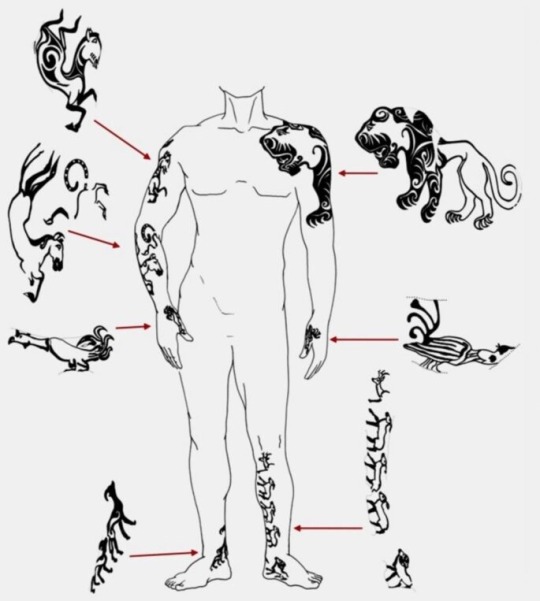

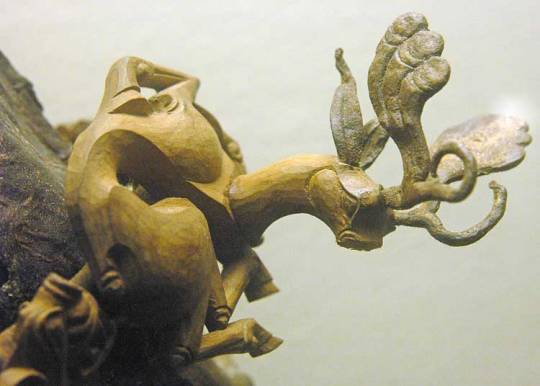


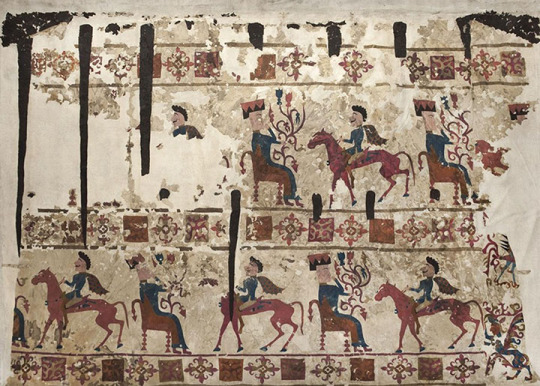



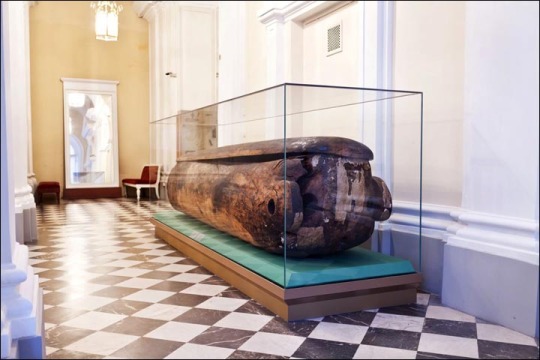






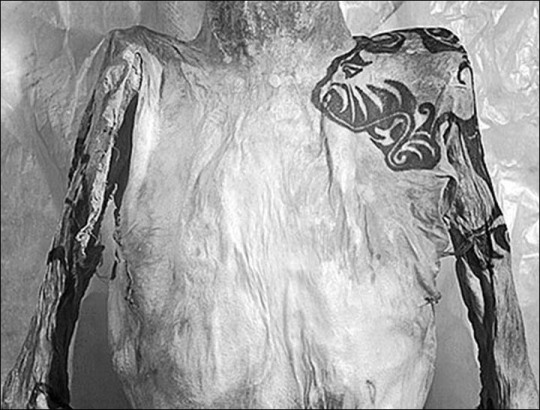
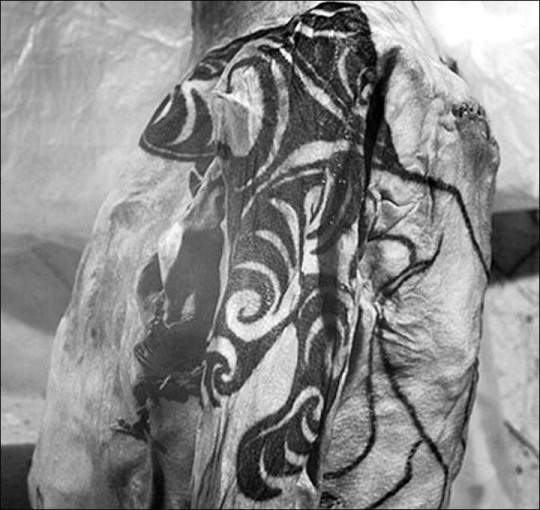



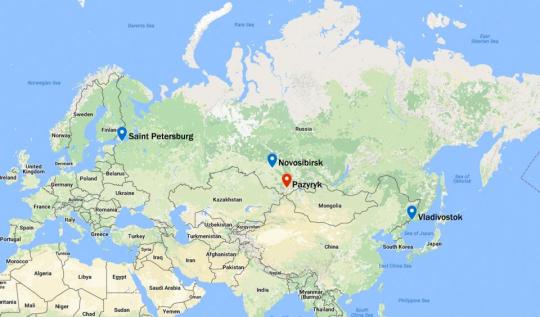

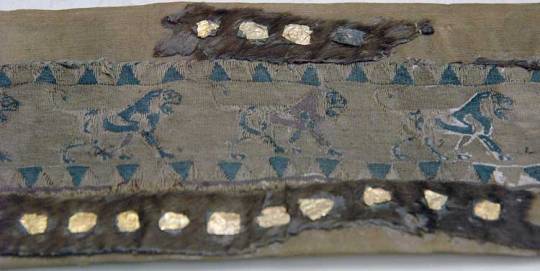
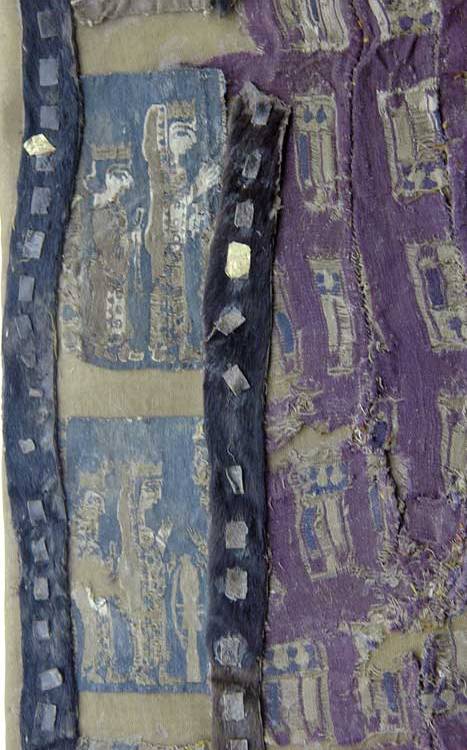



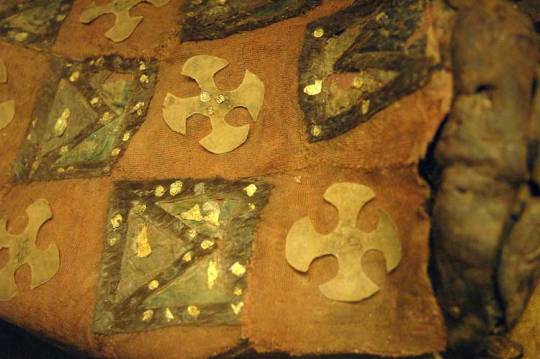
Scythian mummy tomb (Fifth Pazyryk Kurgan), Pazyryk culture 3rd C. BCE. More pictures on my blog, link at bottom.
"The pair were buried alongside nine horses, a huge cache of cannabis and a stash of priceless treasures - including the world's oldest carpet and an ornate carriage.
The man had curly hair and was aged between 55 and 60 when he died, whilst the woman was about ten years younger.
It is believed he was a chieftain or king of the Pazyryk civilisation, which lived in Kazakhstan, Siberia and Mongolia from the 6th to 3rd centuries BC."
...
"The attractive log cabin was a prefabricated construction by the prehistoric Pazyryk culture to house an elite tomb - in which was buried a mummified curly-haired potentate and his younger wife or concubine.
The mound in the Altai Mountains was originally 42 metres in diameter, and this tattooed couple went to the next life alongside nine geldings, saddled and harnessed.
The house itself, recently reconstructed, was not built as a dwelling but nevertheless is seen by archeologists as showing the style of domestic architecture more than two millennia ago.
This structure was the outer of two wooden houses in the large burial mound in the valley of the River Bolshoy Ulagan at an altitude of around 1,600 metres above sea level.
The core of the mound including the ice-preserved bodies of the elite couple had been excavated by Soviet archeologists in 1949, and many of the finds are on on display in the world famous State Hermitage Museum in St Petersburg.
As we have previously written, the pair - who owned perhaps the world’s oldest carpets - are currently undergoing an ultra modern medical scan to establish the cause of death, and reconstruct the appearance of the ancient pair, and to study the techniques of mummification in more detail.
Yet in 1949 this fascinating house was left in the permafrost ground - and only retrieved now from the so-called Fifth Pazyryk Barrow, to the excitement of archeologists.
Head of the excavation Dr Nikita Konstantinov from Gorno-Altaisk State University, was full of admiration about the skills of the ancient craftsmen.
���We took out the log house and reassembled it right next to the mound,’ he said.
‘We made kind of express reconstruction, which made it possible to study the log house in detail.
‘Notches were made on each of its logs - building marks…’.
This was like IKEA instructions today for building their products, telling modern day excavation volunteers how to correctly construct the prehistoric building kit.
The result is seen in the pictures shown here.
‘This log house was first built somewhere away from the mound, then it was dismantled, brought and reassembled in the pit,’ said Dr Konstantinov.
‘Today we build in similar way, using Roman numerals, as a rule.
‘In those times they simply made different numbers of notches.’
The archeological team followed the code left by the ancient craftsmen and reassembled the house without problems.
‘The Pazyryks knitted the corners of the building in a masterly way and chopped the attachment points of these logs.
‘They fitted very cleanly….
‘When we built the log house and began to measure the height, it turned out that the height difference in the angles is only one centimetre.’
In modern constructions, a difference of 7 cm is allowed which showed how skilful were the ancient craftsmen.
He said: ‘This is a funerary structure, but we can say with a high degree of probability that the log cabin was created in the image and likeness of the houses in which the Pazyryks lived."
-taken from siberiantimes and thesun
#scythian#pazyryk#saka#pagan#archaeology#anthropology#architecture#history#ancient history#museums#mummies#artifacts#antiquities#ancient art#tattoos#4th century bce
416 notes
·
View notes
Text
babe tonight i'll be the scythian queen entombed in a burial mound with her jewels and you be the archaeologist unearthing me with methodic and tender attention
12 notes
·
View notes
Text
Okay so one of the symbols of modern Kazakhstan's independence is Altyn Adam - Golden Man*(as in person).
Altyn adam refers to an artefact that was found 1970 in Issyk kurgan(burial)*.
It looks like this(id in the end of the post and in alt):
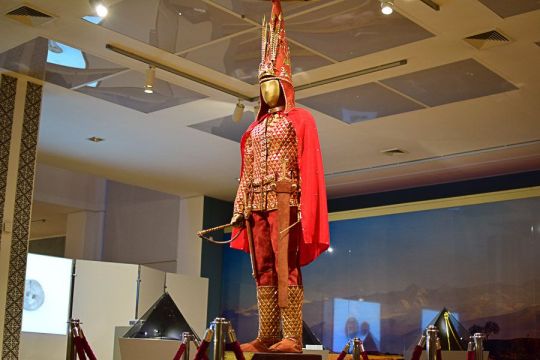
It is actually quite interesting how the artefact was found.
In 1968 the town Issyk became a town and wanted to develop. However, they needed experts to first check that there are no historical sites, which is what they did. For all of 1969 they were carefully uncovering he kurgan, and in 1970 they finally opened it.
It was empty. The place had signs that it has been robbed several times before.
One archeologist, Bekmuhanbet Nurmuhanbetov*, decided to check some 30-40 meters away, and found a side-burial which was left untouched since 6-5th century BC.
They found so many artefacts that listing them all here would be quite difficult.
What I would like to mention though is who was buried here:
Gender is unknown*, but the age is around late teens(16-18)
The person that was buried here was most likely to be a child of some kind of tribe leader, because their burial is smaller than the main one.
About the tribe! The burial probably belonged to Saka tribes. Saka people might relate to Scythians(they are probably part of the same cultural group?)* *. Anyways this particular kurgan was made by Tigraxauda people. Their name derives from persian and means. Pointy hats........
The golden armor is probably more ritualistic(haven't seen it in direct text sorry) than anything because the golden pieces of armor are wood covered in golden leaf. The helmet is made from golden plates though.
There are actually some interesting thing that are present on the helmet. By that I mean the arrows, which are said to symbolise 4 parts of the world. There are also multiple animals* on it. As a whole the costume consists of 4000 golden pieces.
And finally, Why is it so important?
Well to answer this question, you should know USSR's relationship with history and how is was teached in Kazakhstan specifically: mainly, world history through the lense of revolution and how Kazakhstan just sorta became part of USSR after it was Russian Empire's colony*. Nothing before that as people that lived on this land.
Which led to a very hard situation after the independency was gained because well. The majority of people were Kazakhs, but a lot of culture and identity was lost. And part of it was history.
So an artefact this old brings a sense of legitimacy. It also doesn't hurt that it's pretty.
ID and notes under cut
[ID: Armor on a mannequin in a museum setting standing above camera. The mannequin is wearing long-sleeved jacket which is a mix of red fabric and triangular golden pieces. The same pattern is on its boots. The pants are made from a red fabric. It is wearing a very large conical headpiece almost as tall as its chest(40cm). It is very pointy. The headpiece has 4 golden arrows and some animal ornaments on it. The figure has a bow and and an arrow in its hands, and a sheath for sword and another weapon on its belt. It is also wearing a red cape just reaching its thighs. ]
* Actually there are several artefacts like this! Around 6 or so which were found in different regions at different time. All of them are called golden men, just the place that varies. This one is Issyk's Golden Man. Some of them are actually made from solid gold and not gold leaf which I find fascinating.
* Ok so kurgan is used interchangeably here with burial. And in a way kurgan is a burial. It is also in a way like a pyramid? There are things left for the dead so they can carry them to the afterlife, but the kurgan itself is built a bit in and above ground. The rooms are made from logs, and then covered with dirt to create mounds. I also heard that a herd of horses would run it over a bunch of times to set the earth.

*Full name Bekmuhanbet Nurmuhanbetov Nurmuhanbetovich. He eventually organized a museum for the kurgans he found. He died in 2016, at the age of 81, and for some reason he has "Bekem-aĝa"(aĝa means older brother, uncle just an older friendly male figure) as his pseudonym on his Wiki.
*Actually Saka seem to had been pretty great about equality. There is also a very cool story about their female chief Tomiris.
*Historical records about nomadic people come exclusively from settled ones. Because a lot of stuff they would probably write on(despite the claims about lack of writing system) would't have survived because you know. Nomads.
*Haven't mentioned it in the post but sometimes Saka people are called ancestors of Kazakh people and uhhhh. They are probably more related to modern Europeans than to us. They still had similar lifestyle and lived on this land though. And they were more mixed than anything because you know, race is bullshit.
* Oh also fun fact one of the animals is a tulpar which is a horse with wings. The same mythical animal is present on Kazakhstan's official coat of arms.
*should I keep making these notes? because I feel they might take away from the flow of the text, and some details are simply not that important or I cannot convey them properly. so. what do you think?
#the whole legitimacy thing is of course not just kazakhstan#every country out there is doing it tp build a cohesive narrative that people can unite around#kazakhstan#kazakh#kazakh culture#kazakhstan history#kazakhstan politics#kazakh history#Kazakhstan culture#ussr#history#asia#central asia#cw: mention of death#what warnings should I put?#ussr culture#ussr education
65 notes
·
View notes
Text

It’s Scythian Empire! The basis for the Amazons from Greek mythology
they were still a largely patriarchal society but they certainly had powerful female warriors, as seen in their burial mounds
12 notes
·
View notes
Text
My next post in support of Ukraine is:
Next site, Kholodnyi Yar in Cherkasy Oblast. It's a relict forest of historical and environmental significance. I did have to look up what a relict forest is. It means it is a forest that has survived from a much earlier time, a forest that dominated the area around 10,000 to 20,000 years ago, but has now been reduced to 6,804 hectares (around 16,813 acres). The forest is home to many archaeological, historical, and scientific sites. There's over 150 of them in the area, from sites of the ancient Trypillian culture to Scythian mounds. The Kholodnyi Yar National Nature Park was established on January 1, 2022, so only a little over a month and a half before the full-scale invasion of Ukraine was started by muscovy on February 24, 2022.
#StandWithUkraine
#СлаваУкраїні 🇺🇦🌻


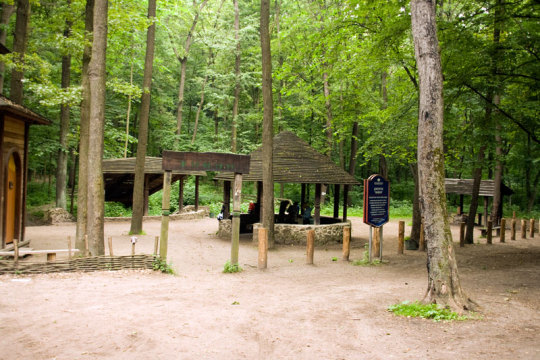

11 notes
·
View notes
Text
*watching a video on Scythians/sarmatians*
"Omg there were legends of them being amazons but that's fake ofc."
"Wow it's crazy every burial mound we found has a queen buried with other women or her male soldiers /servants. So this ✌️queen✌️.."
If they were males no one would doubt they're royals. Why is this so hard to believe that women were warriors and directed their tribes even if every artifact points in this direction...
14 notes
·
View notes
Text
Photos of a married couple


A decent couple of Mr Sleeper, an employee of the secret police, and his beautiful wife. Some conservatives spread rumors and disapprove of their interracial marriage, but as enlightened citizens we will not condemn it. After all, what do we care why a wandering dreamer chose a blood-eating ghost from an ancient Scythian burial mound as his wife.
"Colleagues think I'm a little crazy, they say, why did I "take my job home", because the task of my ministry is to expel evil spirits and ghosts, but I assure you, my Moonface one is completely different, a more honest and modest girl cannot be found",- commented Mr. Sleeper specifically for our edition of the telepathic newspaper
#my art#illustration#art#digital art#horror#artists on tumblr#creepy art#ghost#mystical#my ocs#oc art#original character
14 notes
·
View notes
Text
Archaeologists have unearthed gold jewelry, arrowheads, and a large, bronze mirror from roughly 2,000-year-old burial mounds in the Turkistan region of southern Kazakhstan.
The artifacts are thought to have been made at the time of the Kangju state, a little-known entity that ruled the region between the fifth century B.C. and the fourth century A.D.
According to a translated statement by officials at Turkistan's regional government, the finds show the highly developed craftsmanship of the region when the Kangju state traded with ancient Rome, ancient China, and the Kushan Empire farther south.
From its style — circular, with an eight-sided arched design on the back and a hole in the center for a thread — the bronze mirror seems to have originated in China during the Han dynasty, which ruled from 206 B.C. until A.D. 220.
Such items were highly prized throughout Eurasia — similar mirrors have been found in Afghanistan and the southern Ural region — and it was a sign the woman it was buried beside had been wealthy and influential, according to the statement.
Ancient state
A team from Kazakhstan's Ozbekali Zhanibekov University and local government archaeologists discovered the new finds in three burial mounds in Turkistan's Ordabasinsky district. They reported that two of the mounds had been looted in ancient times but that the third burial mound contained valuable relics, the statement said.
In addition to the bronze mirror, the artifacts included a Roman-style brooch called a fibula; large and small beads; a pottery jug; a shoe; a belt buckle; an arrowhead designed for hunting birds; and two gold earrings that are thought to date from the first century B.C.
The earrings are especially ornate. They are fashioned with a colorful alloy known as "polychromatic" gold, inlaid with turquoise and rubies, in a crescent shape meant to represent the moon, with lower decorations that represent clusters of grapes and were designed to reflect sunlight.
Expedition leader Aleksandr Podushkin, an archaeologist at Ozbekali Zhanibekov University, said the Kangju state was a federation of different peoples, including, at times, nomadic groups of Sarmatians, Xiongnu, and Saki (who may have been Scythians).
The location of the Kangju cities on parts of the Great Silk Roads between China and the Mediterranean meant they had diplomatic and trade connections throughout the ancient world, he said in the statement.
The artifacts will now go on display in the National Museum of the Republic of Kazakhstan in the city of Astana, Podushkin said.
3 notes
·
View notes
Text

"Riders of the Sidhe" (1911) by John Duncan.
The Wise Ones
"As the fairy populations in each region died out completely, the incomers were left with a memory of a small elusive folk who, as time passed, became smaller still in the mind’s eye of those who, though responsible for their genocide would, nevertheless, rather forget them altogether.
The words gnome, sprite and goblin; like fairy, elf and pixy therefore all refer to one race: The Scythians or Sidheans, and relate to various practices and ritual identities amongst this once ancient and noble people.
’Gnome’ comes from the Greek and is related to the root ’gno’. From this same root we obtain our words gnosis and gnobilis or nobilis. Both these words relate to knowledge and wisdom, and point to an origin within the Aryan culture, Aryan also meaning wise, or ’Race of the Wise’, ’The Noble Race’.
A ’Gnome’ is one of the race of the Wise Ones, the ancient king tribe of the Aryans or Scythians, who were the genetic guardians of a blood chemistry, of rituals and lore from which they derived a perceptual state of gnosis or transcendence. The gnome is said to have been a creature of the mines and mounds, just like the hobgoblin.
This description, linked both to alchemy and smithing, is also associated with their ritual practice of living in specially prepared chambers in burial mounds, tombs and pyramids which links the gnome, as a priest-king figure, with the cult of Nergal and the otherworld or underworld.
For this very same reason the fairy is also called the Sprite. This word is a reduction of the word Spirit and also has the same associations with the Scythian practice of regularly inhabiting tombs to obtain knowledge from the ancestors.
Gnome (also relating to ’judge’) as Nobilis gives us another familiar name for the fairies - the Gentry or Noble ones. Gnome also refers to a canon or body of law and this is reminiscent of the role of the Pictish - "pixy" - Druidic High Kings as custodians of the Law and Culture of their peoples.
These Kings, the Brudes or Bruidhes, were the Judge-Poets and magicians whose expertise lay in spellcraft, rhetoric and satire. Their female counterparts were the Bruidhinas, Sirens, Morrigans and Melusines, the Raven women and Swan Maidens, female "Gnomes", Ban Sidhes - female fairies - the custodians of wisdom and law, weavers of spells and vampire princesses, which is exactly what Melusine d’Avalon was. The Sprite is additionally known as the Goblin and the origin of the epithet "Red Cap" actually derives, not solely from the later need for the consumption of human blood as a staple food, but originally from the ritual practice of coloring the Hood or Cap with menstrual blood, which was consumed, along with its precious cargo of neurotransmitters, to facilitate wisdom."
The Dragon Legacy: The Secret History of an Ancient Bloodline - Nicholas de Vere
4 notes
·
View notes
Photo










A 2,000-Year-Old Scythian-Style Cemetery Discovered in Siberia
Clearing a mound to make room for the newly deceased in Krasnoyarsk, Siberia revealed tombs from a culture unique enough to warrant its own definition, archaeologists say.
While bulldozing land for a new burial ground, workers startled to discover an old one, belonging to a newly identified culture
All they meant to do is expand a local cemetery. But as gravediggers in Krasnoyarsk, Siberia, were removing a hill to make room for the newly deceased in 2018, they made an unexpected discovery. That hill turned out to be an ancient burial mound created by a Scythian-type culture over 2,000 years ago.
The question is which Scythian-type culture.
Our story begins in the 19th century, when a new cemetery called Shinnoye was established on the outskirts of Krasnoyarsk, the second biggest city in Siberia. Little did the founders know that the land nearby had already been “used”.
A century later, excavation of what remained of the ancient burial mound began in autumn 2021 and continued the next summer by a team of archaeologists from the Siberian Federal University, led by Dmitry Vinogradov.
In fact, around 150 ancient burial mounds are now known to have existed around Krasnoyarsk, but most were destroyed in the course of city development during the 20th century. This was the first to be excavated in the region in 65 years.
The chamber of death
It is indeed unfortunate that while expanding the modern cemetery, the ancient mound was bulldozed. Valuable data was destroyed, but based on old photographs and descriptions from an archaeological survey almost a century ago, the mound had been round and about 30 meters in diameter. However, the knowledge about it was lost over the years. Its existence was only rediscovered by the bucket of the bulldozer a century later.
Luckily, the tomb beneath survived the bulldozing and turned out to contain dozens of bodies in a large rectangular pit, that had been walled with timber and carpeted in birch bark.
The upper part of the tomb was damaged by the worksbut parallels with tombs from the era suggest it once had a wooden roof, thus creating what is known as a box tomb, Vinogradov explained.
Preliminary counts suggest the tomb may have contained as many as 50 people buried with grave goods ranging from beads to bronze plaques, miniature symbolic bronze daggers and battle axes, as well as knives, mirrors, and needles; and ceramic vessels that had contained foods: all items the deceased might have “needed” in the afterlife, Vinogradov speculates.
One plaque depicted a stag, a popular motif in Siberian Scythian animal art.
But the question remained, which Scythian-type culture this was.
Signs of Scythians
The Scythians are known mainly as the ��barbarians” living in Crimea and north of the Black Sea, according to classical authors, mainly Herodotus from the fifth century B.C.E. However, the Eurasian steppe belt, as far east as northeastern China, was home to numerous horse-riding nomadic and semi-nomadic archaeological cultures that the Russian school of archaeology calls “ Scythian”.
Make no mistake. Scholars today do not ascribe to a theory of some broader unified “Scythian” nation or culture. Rather, the name refers to a triad of Iron Age archaeological features: certain styles of bronze weaponry; horse-riding gear; and art featuring real and mythical animals – mainly stags, wild felines, birds of prey and mythical griffons.
A lot of cultures throughout the sprawling Eurasian steppe belt featured the “Scythian triad” of artifacts, but the ethnic, genetic or anthropological connections between them – if any – remain unclear and highly debated, especially concerning the most far-flung of the “Scythian-type” communities.
For example, Scythian-type archaeological cultures in the Minusinks basin in Siberia are not thought to have any relationships with the classical Scythians in Crimea or the Northern Black Sea, but rather to be related to closer people in Siberia’s Altai mountains.
It can also be said that from the Bronze Age onward and continuing into the Iron Age, there were connections between northeastern China and the Minusinsk basin in Siberia, but researchers still debate who influenced who and how. In any case, these “Scythian” cultures encompassed the full gamut of lifestyles, from nomadic to semi-nomadic to sedentary.
One of the more famous “Scythian-type” cultures is the Pazyrysk living in the Altai mountains, Kazakhstan and Mongolia, best known for the Princess of Ukok and her beautiful tattoos.
Another famous Scythian-type culture is the Tagars, a semi-nomadic people who dominated the Minusinsk Basin during the late Bronze Age and Iron Age. On a number of grounds, the archaeologists suspect that the burial mound inadvertently unearthed by the latter-day gravediggers in Krasnoyarsk is associated with the Tagars.
In the early phase of their culture, the Tagars buried their deceased individually in stone box graves. In later phases, the fashion tended to large-scale wooden box tombs featuring multiple bodies, perhaps accruing over generations. And when the grave was full, the whole lot would be set collectively on fire.
Burning the dead
The large number of skeletons in the newly discovered tomb may attest that it served as a family tomb used for generations, Vinogradov suggests. When the tomb was full, it was sealed off, set on fire and left to burn.
This conclusion is supported by the colour and nature of the soil, which attests to high temperatures – and the fact that the bones had become mixed up inside, making the work for the physical anthropologist quite challenging. Usually, after burning, the tomb would be covered in soil, and that is what created the burial mound known throughout the steppe as kurgans.
However, death in the community did not end with the construction of our kurgan, as indicated by the discovery of ten pit burials around it. In fact, it was not rare for Tagar kurgans to feature later pit burials dug inside them as well. Luckily for posterity, the pits also survived the destructive claw of the bulldozer.
Each pit burial contained one or more individuals. Contrary to the wooden chamber of death, these tombs were not ignited. The dead were laid to rest in different positions – on their backs, chest, or side. Some skeletons survived the vagaries of time while others were less lucky, lacking any surviving bones, let alone articulation (anatomical order).
Nor was there a pattern to the dead in the pits: they contained both different sexes and all ages, including children. Only three contained grave goods, such as pottery and bronze, the same type as found within the wooden tomb.
From ashes, a new culture is born
The kurgan in Krasnoyarsk is similar to others in the Minusinsk basin, south of Krasnoyarsk. These types of kurgans are often associated with the Tagar culture (8th – 1st-century B.C.E).
The Tagar culture is divided into several stages. The style of our particular kurgan is similar to those from the later stages of this culture, from about 2,400 to 2,100 years ago.
The Tagars inhabited the basin from the 8th century B.C.E., the late Bronze Age. Toward the last centuries of the first millennium B.C.E, migration processes in the basin forced them to move northward, including to the territories surrounding the modern city of Krasnoyarsk. If in the early stage of their culture, the Tagans buried their dead individually, collective burials followed by cremation of the full graves marked the later phase of the culture: That was something completely new, Vinogradov explained.
Another hallmark of this final stage is that the dead were no longer buried with real bronze goods but rather miniaturized versions of these items, which presumably were of symbolic significance, the scholars believe.
Based on archaeological finds over the years in the region, some scholars have been suggesting that the late stage of the Tagar culture in the second and first centuries B.C.E., be considered a separate stage, which they call the “Tesinian culture” based on the site where these archaeological traits were first observed, on the banks of the River Tes in the Minusinsk Basin. In fact, the “Tesinian distinction” was first suggested by the late archaeologist and historian Mikhail Gryaznov (1902 – 1984), a leading scholar of the steppe cultures. .
These Tesinians retained Tagarian traditions, from pottery style to burying the dead in kurgans with miniature items. While the Tagars did use iron, the metal only became common during the Tesinian stage and the metal started to appear in burials as well, a feature associated with the following Tashtyk culture.
Another practice whose roots we see in the Tesinian period was burial with plaster masks. These masks would become a hallmark of the later Tashtyks.
By the time of the Tashtyk culture, which flourished in the area from the 1st to the 4th century C.E., we no longer see miniature bronze items but rather iron and wooden items.
Hence, scholars today believe the final stage of the Tagar culture should be classified as a separate culture, because of the various new traditions they have observed. They believe this Tesinian culture arose from mixing between the Tagars and other populations coming from Central Asia during this time.
At this point however there are more questions than answers, Vynogradov explains.
So, based on the character of the burial mound and the goods, the kurgan is believed to belong to the transitional Tesinian culture and to date to the second or first century B.C.E. And that is the story of the first ancient mound in Krasnoyarsk to be excavated in 65 years, which revealed a people who emerged on the outskirts of the known territories of the Tagars, and may be unique and different from anything we knew before. And perhaps further archaeological investigation will teach us about what might have driven the Tagars north into these territories, and who were the Tesinians they became; and how and when they lived, and how they died.
By Viktoria Grinboim Rich.
#A 2000-Year-Old Scythian-Style Cemetery Discovered in Siberia#Krasnoyarsk Siberia#ancient graves#ancient tombs#ancient artifacts#archeology#archeolgst#history#history news#ancient history#ancient culture#ancient civilizations#scythian culture#scythian history#long reads
27 notes
·
View notes
Text
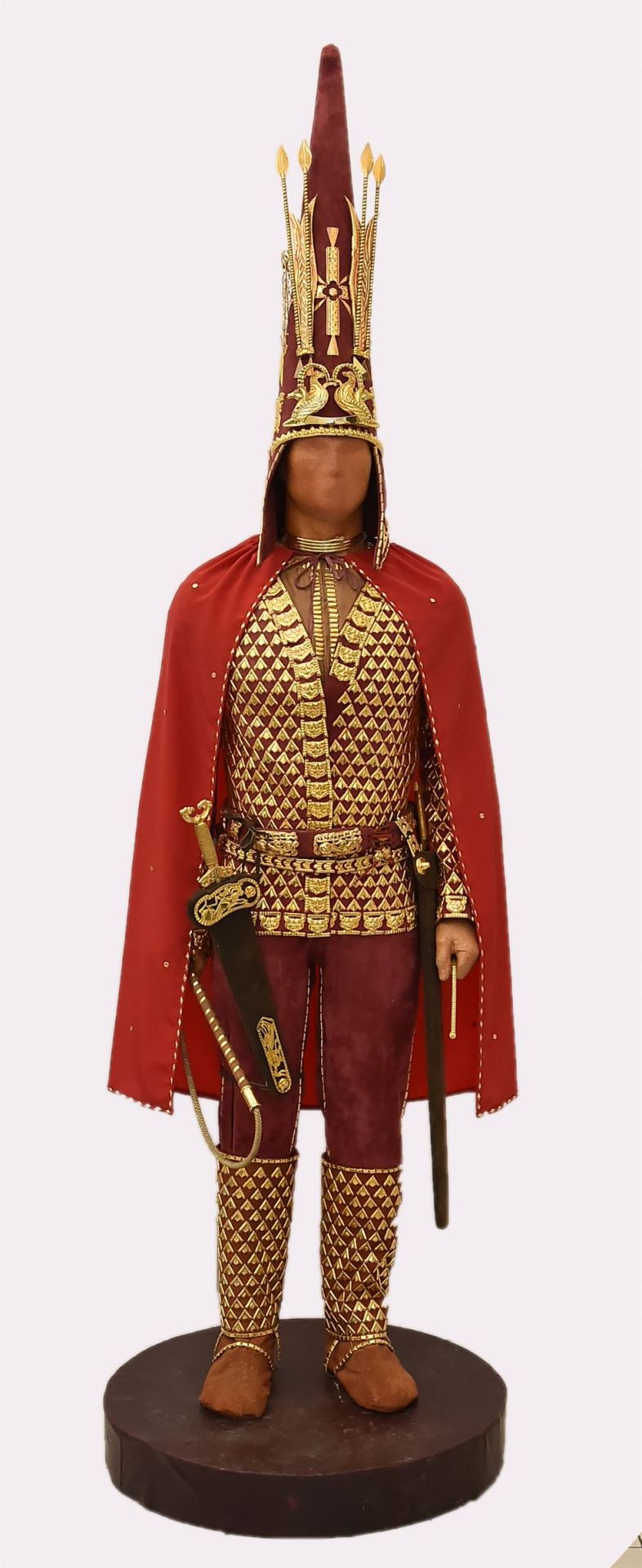

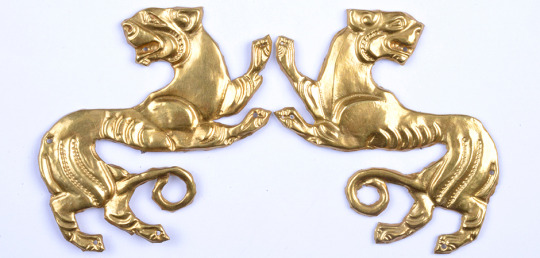
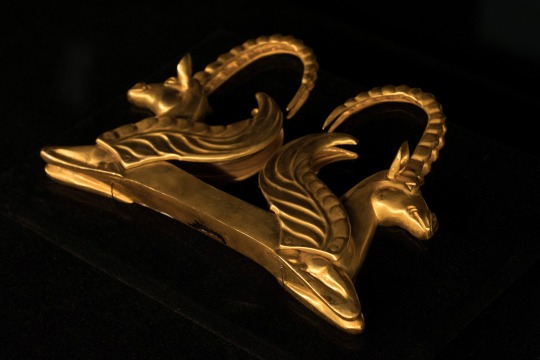
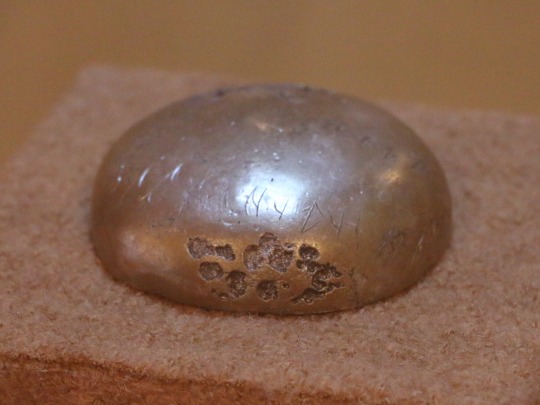

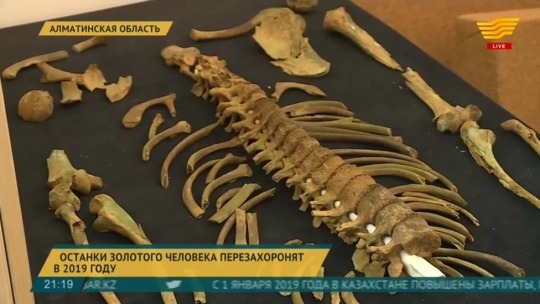


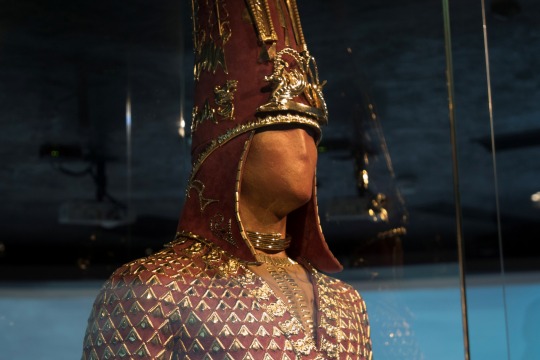
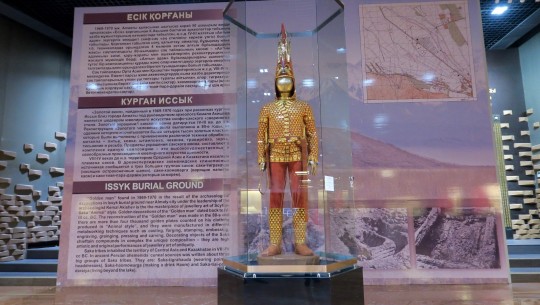

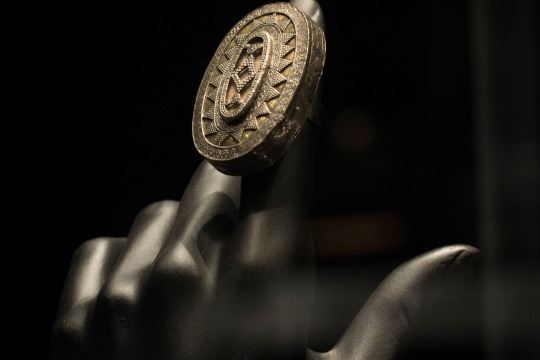
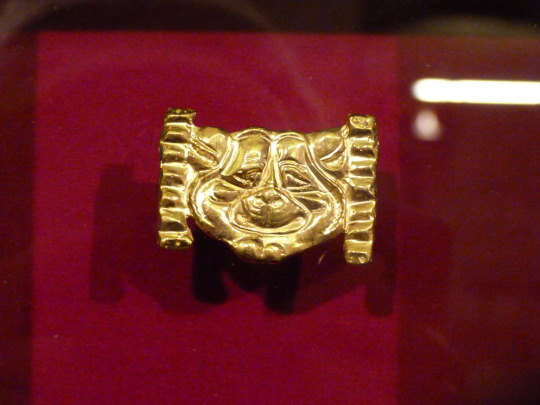
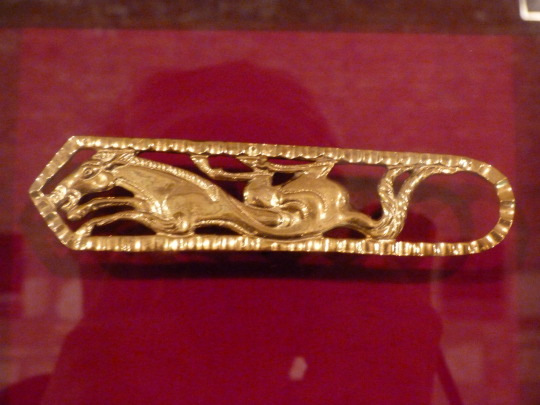
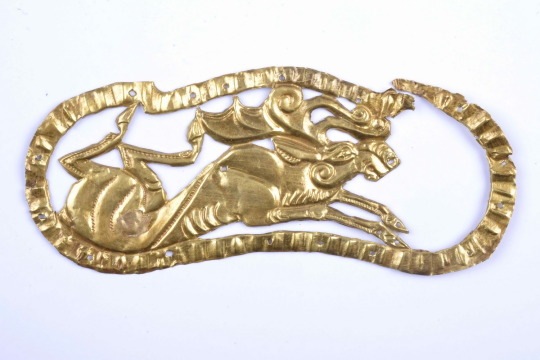
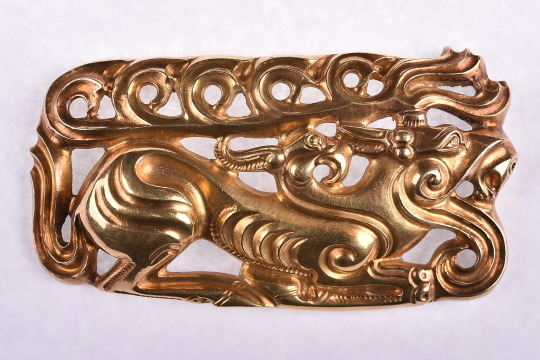
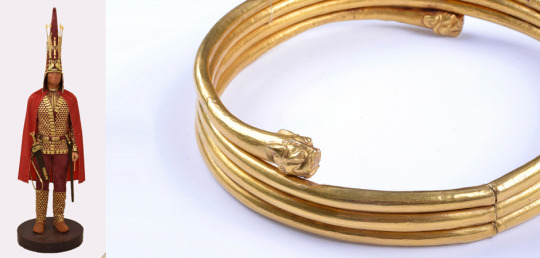
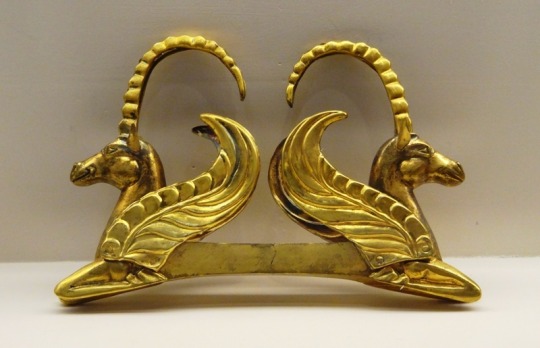
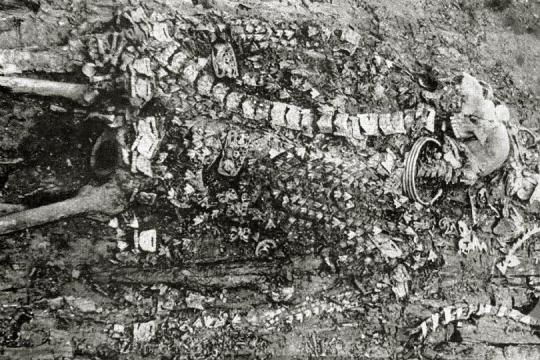


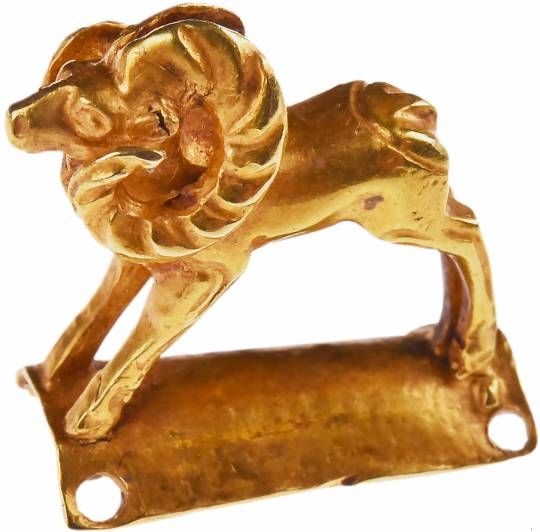

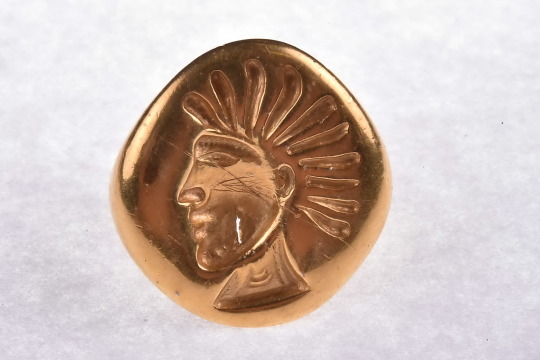
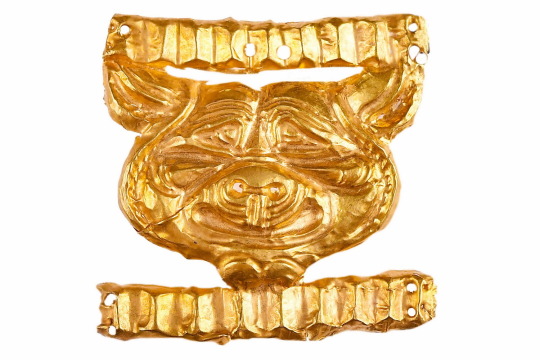
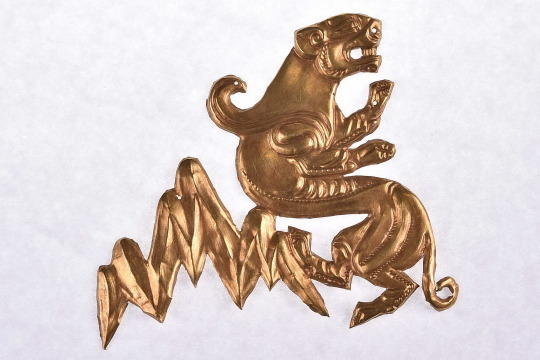

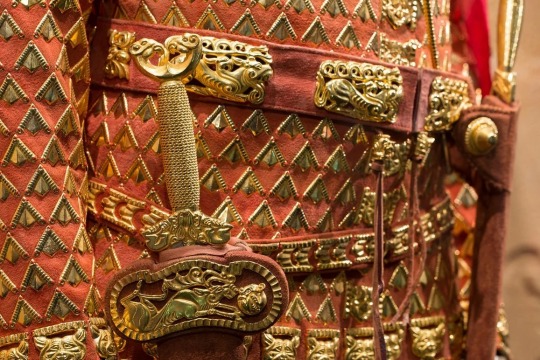
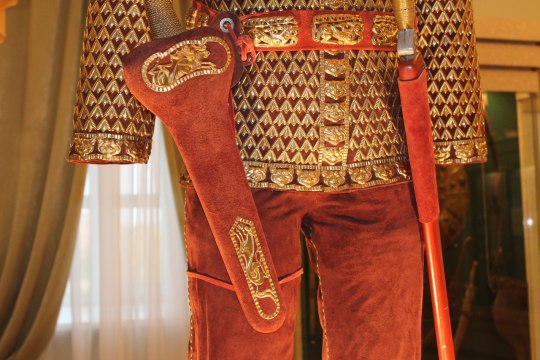
The Issyk kurgan of the 'Golden Man' 6th-3rd C. BCE
"The Issyk kurgan, in south-eastern Kazakhstan, less than 20 km east from the Talgar alluvial fan, near Issyk, is a burial mound discovered in 1969. It has a height of six meters and a circumference of sixty meters. It is dated to the 4th or 3rd century BC. A notable item is a silver cup bearing an inscription. The finds are on display in Nur-Sultan. It is associated with the Saka peoples.
The burial complex located on the left bank of the Issyk Mountain River, 50 kilometers to the East to the Almaty city. The unique archaeological complex found by a small group of Soviet scientists led by archaeologist Kemal Akishevich Akishev in 1969. The burial ground consists of 45 large Royal mounds with a diameter of 30 to 90 and a height of 4 to 15 meters. The Issyk barrow is located in the Western half of the burial ground. Its diameter is 60 meters and its height is 6 meters.
Situated in eastern Scythia just north of Sogdiana, the kurgan contained a skeleton, warrior's equipment, and assorted funerary goods, including 4,000 gold ornaments. Although the sex of the skeleton is uncertain, it may have been an 18-year-old Saka (Scythian) prince or princess.
The richness of the burial items led the skeleton to be dubbed the "golden man" or "golden princess", with the "golden man" subsequently being adopted as one of the symbols of modern Kazakhstan. A likeness crowns the Independence Monument on the central square of Almaty. Its depiction may also be found on the Presidential Standard of Nursultan Nazarbayev.
There were two burials in the grave complex: the Central one and the Southern one (to one side). Unfortunately the Central burial site had been robbed but the side grave was undisturbed. The burial chamber in the side grave was constructed from spruce logs. The tomb and its contents remained intact and buried. The skeletal remains were found in the Northern half of the chamber. More than 4,000 gold items were found in the chamber, as well as iron sword and dagger, a bronze mirror, vessels made of clay, metal and wood, shoes, headdresses, gold rings, statuettes, bronze and gold weapons, and an inscribed silver bowl dating from the 6th to 5th century BCE. Many clothing ornaments made of gold, a headdress and shoes were found on and under the remains. Next to the remains were an arrow with a gold tip, a whip (the handle of which was wrapped with a wide ribbon of gold in a spiral pattern) and a bag containing a bronze mirror and red paint. Scientific research, particular that of the anthropologist O. I. Ismagulov, shows that the remains belong to a member of the Saka peoples of Semirecheye, who have a European appearance with an admixture of Mongoloid features. The age of the body at death is estimated at 16–18 years, and its sex is indeterminate. The form of clothing and method of burial suggest that "The Golden Man" was a descendant of a prominent Saks tribe leader, or a member of the Royal family.
A text was found on a silver bowl in Issyk kurgan, dated approximately VI BC. The context of the burial gifts indicates that it may belong to Saka tribes.
The Issyk inscription is not yet certainly deciphered, and is probably in a Scythian dialect, constituting one of very few autochthonous epigraphic traces of that language. János Harmatta, using the Kharoṣṭhī script, identified the language as a Khotanese Saka dialect spoken by the Kushans.
The Wikipedia page has a possible (partial?) deciphering of the Issyk inscription as: "The vessel should hold wine of grapes, added cooked food, so much, to the mortal, then added cooked fresh butter on".
...
Kazakhstan will rebury an iconic ancient warrior in a time capsule this year (2019), in the hope that future generations will be able to establish who he really was, Kazakh TV reports.
Since independence in 1991, he has become a symbol of Kazakhstan's national heritage. His armour takes pride of place in the national museum in Astana, and tours the world as a calling card of Kazakh culture.
The bones were only rediscovered recently at a forensic institute, stored in a cardboard box with a scribbled note reading "The Golden Man, May He Rest in Peace".
"We know his age and social status, while DNA tests could provide us with exhaustive data," researcher Dosym Zikiriya told Kazakh TV.
But Yermek Zhasybayev of the Issyk Museum held out little hope of this. "The bones are in a bad state. They have been kept in a cardboard box for 50 years and been exposed to all sorts of bacteria and viruses, including modern ones. It is now impossible to get a full DNA transcription - if only we had the skull, or just one tooth," he told the TV channel.
Scientists say their only hope is to seal the remains in a special time capsule to prevent any further decomposition, so that technological advances might allow future generations to glean more information about the long-dead warrior.
In recognition of the Golden Man's status, the capsule will be "ceremonially buried in keeping with ancient royal traditions", Kazakh TV said.
Archaeologists are confident that the remains date back to at least the 2nd-3rd century BCE, when south-eastern Kazakhstan was home to the Saka people, who are believed to have been part of the broader Scythian nomadic confederation.
They were gradually displaced by the arrival of the Kipchak Turk ancestors of the Kazakhs, but modern Kazakhstan has taken the Golden Man to its heart."
-taken from wikipedia and bbc
#saka#scythian#scythian gold#archaeology#anthropology#history#ancient history#antiquities#antiquity#artifacts#museums#ancient jewelry#pagan#6th century bce#3rd century bce
226 notes
·
View notes
Text
Serhii Telizhenko, of the National Institute of Archaeology in Kyiv, who has been monitoring the wave of destruction, said he realised there would be losses after the invasion, “but I could not imagine the scale”.
Some museums managed to move their collections to safety in time. They include Odesa’s archaeological museum and one in Melitopol that holds Ukraine’s most important collection of Scythian gold. Meanwhile Irina Shramko, director of Kharkiv’s archaeological museum, and her colleagues have been spending their nights close to their Scythian and bronze age treasures.
“This is the case all over Ukraine,” said Regina Uhl of the German Archaeological Institute in Berlin, which has been providing money and materials for its Ukrainian colleagues. “They thought they could protect the objects better if they were closer.”
However the rapidity of the Russian occupation in the east of the country, especially, meant many museums had no time to implement their evacuation plans. Local history museums in Lyman, in the Donetsk region, and Rubizhne in Luhansk had been destroyed, Telizhenko said, and the fate of their collections was unknown.
The museum of local lore in Mariupol, which also had an important collection of Scythian gold, was badly shelled in the spring, and in April Russian media announced that about 2,000 objects had been removed from it to the occupied city of Donetsk. They include priceless paintings by Arkhip Kuindzhi and Ivan Aivazovsky.
Ukrainian intelligence claims that much of the material taken from its museums has found its way to Crimea. Telizhenko cited reports that in late October, employees of the Chersonese state museum in Sevastopol, Crimea, arrived at the Kherson regional museum of local lore to remove its collection.
While this report is hard to confirm, it is corroborated by sources in the country as well as exchanges in virtual forums being monitored from outside Ukraine. Much of the destruction and removal of objects has been documented photographically, and the photos published on a website set up by the Ukrainian government to record “culture crimes”.
The website includes images of damaged archaeological sites. Telizhenko said that some of the destruction predated the current conflict. Russian troops began building defensive structures on a cluster of bronze age burial mounds near the village in Dovhe in the Luhansk region in 2017, he said. “The integrity of this complex is lost forever,” he said of the 5,000-year-old site. “There are many such cases, because the warring parties use the features of the terrain for self-defence.”
Archaeologist Mykhailo Videiko of Borys Grinchenko Kyiv University confirmed this: “They dig in for defence, often in places where people did the same hundreds and thousands of years ago.” He noted that ramparts up to nine metres high, built by the princes of Kyiv in the 10th century to repel eastern marauders, successfully repelled Russian tanks more than 12 centuries later.
Sam Hardy, head of illicit trade research at international charity the Heritage Management Organisation, said the loss of ancient sites’ integrity was more serious than the loss of priceless artefacts. “The thing that we get the information from is the context, the relationship between everything, the site rather than the individual object,” he said.
Hardy said that there had been organised removal efforts by the Russians in territories they had occupied, and looting by Ukrainians and Russians – though mostly by Russians. “There’s a huge problem of legal nihilism in both societies,” he says. “People don’t really feel that the law exists or is implemented fairly.”
19 notes
·
View notes